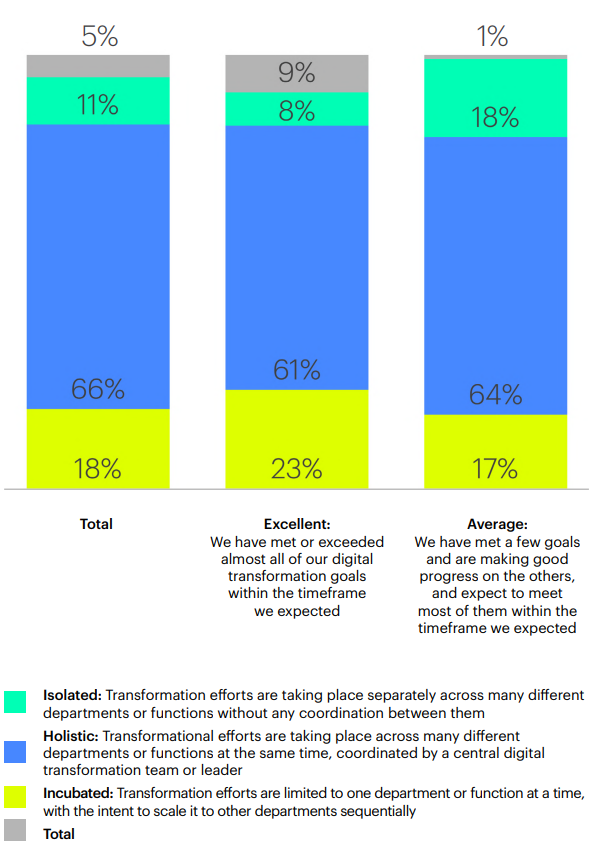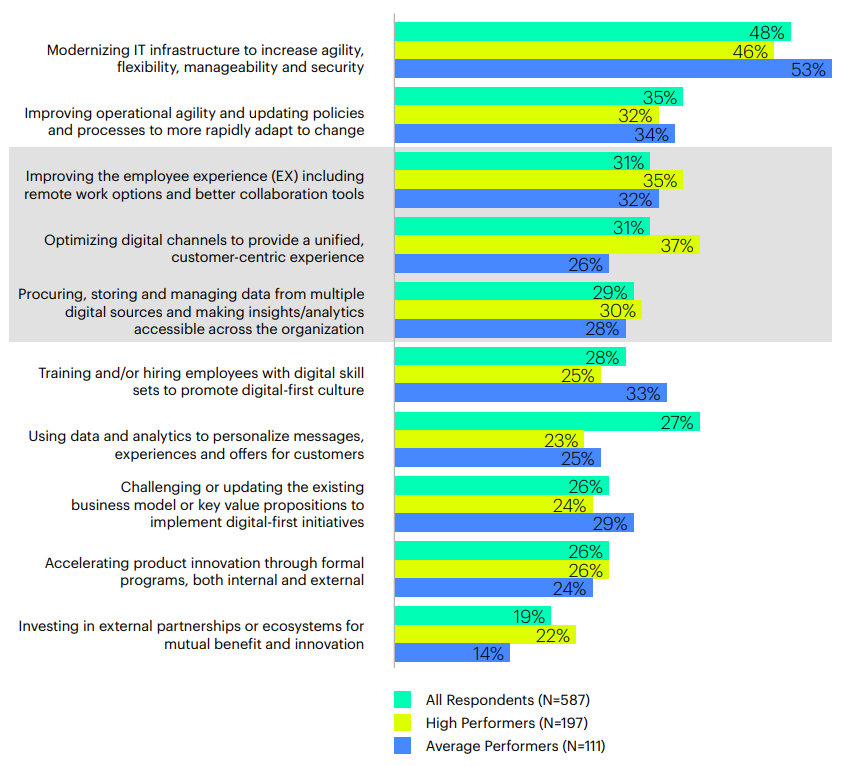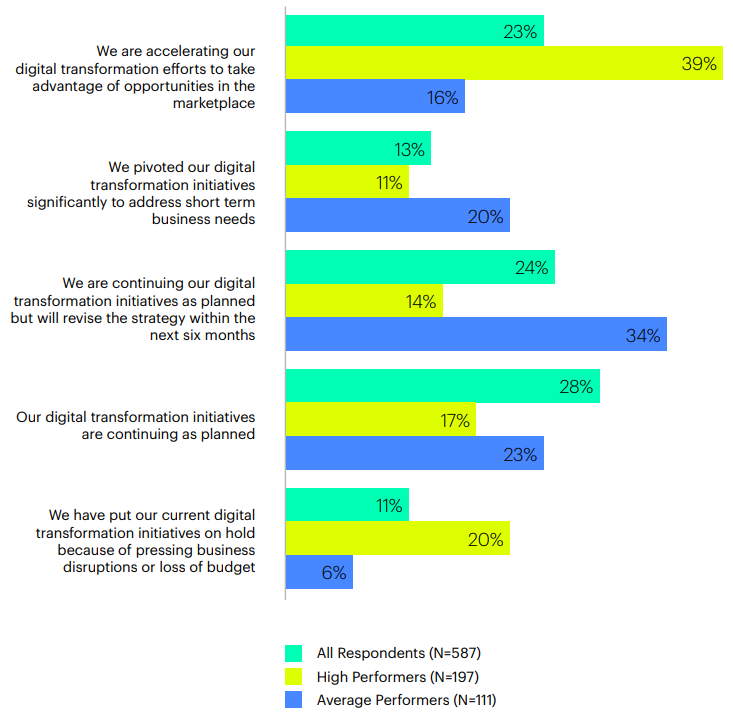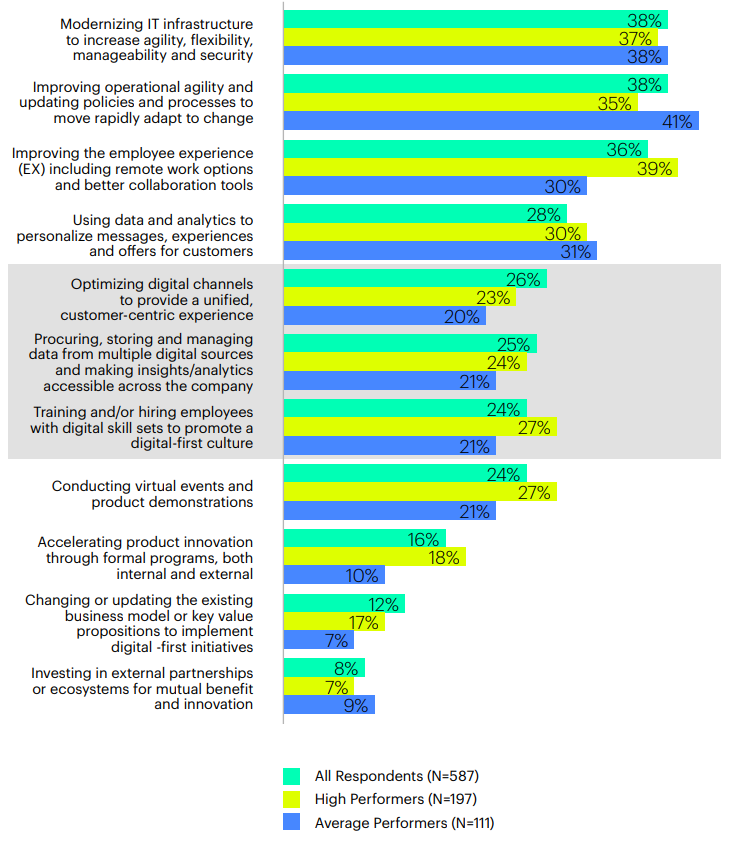As we have discussed in the part one of the series, most companies have started their digital transformation or at least plan for it. However, an industry study shows that only 1% of organizations have their processes sufficiently under control to realize the full potential of digital solutions. This year, the COVID-19 pandemic has brought new urgency to meeting digital transformation goals – and forced many organizations to speed up transformation work. The blog will continue to discuss a process-led approach to digital transformation to accelerate the time-to-value and minimize risk. Let’s get started for advice from your peers and digital transformation success companies.
Table of Contents
Digital Transformation Approach
In terms of which approach best describes how the company implemented (or is currently implementing) its digital transformation program, 66% of survey respondents launched digital transformation programs as a single coordinated effort that concurrently encompassed several departments or functions.
Businesses may have employed the incubated strategy in the past, in which transformation activities were first piloted in a single department before being scaled up to additional departments in a sequential manner. This was done in order to minimize interruption as well as to test and learn before moving forward. As a result of the rapidity with which digital innovation is emerging, as well as the increasing rate of digital adoption, this approach has gone out of favor. Consequently, businesses cannot afford to put off their transformation efforts and are adopting a converged and coordinated simultaneous transformation approach to achieve success. Furthermore, There has been a rise in the convergence of functions and goals amongst multiple departments (such as sales service, marketing), making it increasingly difficult to enhance any one team on its own. It is expected that this form of convergence will also occur with external parties such as apps, data networks, and adjacent businesses, as the interdependence between departments and teams has expanded in the digital age.
The prioritized initiatives for digital transformation program
It is obvious that the majority of organizations began their digital transformation journeys by spending on modernizing technology infrastructures (48%) and operational processes (35%). If a corporation wants to modernize and compete in the digital age, it must address these issues first.
Interestingly, At the top areas, high performers were more likely than ordinary performers to have invested in enhancing digital channels and customer experiences (37%), as well as in creating insights from data (36%). This early focus on digital experiences for both consumers and staff has regularly been identified as a distinguishing characteristic of successful companies in digital transformation. It highlights how top performers are utilizing change to serve their most important people, rather than simply updating for the sake of keeping up with the times.
How has the COVID-19 pandemic changed digital transformation?
The most difficult challenges came up against in digital transformation efforts
With employees continuing to work from home and supply chains and markets being impacted around the world, it’s no wonder that the worldwide pandemic has continued to disrupt all company activities, including transformation. Similarly, Budget restrictions and a culture resistant to change were also significant constraints. The benefits of digital transformation aren’t often immediately obvious, therefore it was often seen as a cost center in many companies.
Transformation can also cause concern among employees in these organizations since it demands technological upgrades, the hiring of new skills, and the reorganization of hierarchies, all of which can contribute to the development of a resistant culture.
On the other hand, the lack of clear vision and risk cautious leadership were not among the top problems. This shows that executives are increasingly capable of directing change. It’s worth noting that ordinary performers were slightly more likely than high performers to identify a lack of leadership as a key obstacle, underlining the importance of effective leadership in achieving transformational success.
The spread of COVID-19 shifted digital transformation initiatives
When it came to evaluating their transformation plans in the event of a global pandemic, most businesses were understandably cautious. As time advanced, several (24%) pledged to reevaluate their change efforts and to keep moving forward at the same speed.
Top performers, on the other hand, were significantly more inclined to accelerate their transformation efforts (39%), demonstrating how they perceived the epidemic as a motivator for urgent change rather than a period of caution.
Clearly, It’s also possible that top performers were more digitally mature to start with, and hence in a better position to accelerate transformation efforts compared to everyone else.
Another key factor driving interest in digital transformation: customer demand for better and more modern functionality. While updating IT, improving operations and the employee experience (particularly for remote work) were the top three goals for all organizations, top performers were more likely to focus on consumer experiences than other companies. It highlights the fact that customer-focused change, rather than technology- or process-focused transformation, was more likely to result in success. As the epidemic forces more businesses to provide digital experiences in addition to physical ones, more data than ever before is being generated as a result.
Top performers made greater investments in using data and making it accessible to diverse functions across the company and effective data usage is increasingly recognized as a key competence for the next phase of digital transformation, as it will continue to drive consumer interaction, product innovation, and external alliances.
In conclusion
Prior to the pandemic, many organizations were just beginning to see the potential that many technology capabilities offered their businesses. But COVID has accelerated the migration to digital. The moment was not just an exercise in fast-tracking technology deployments, it was also a test of companies’ ability to get employees and customers to embrace new forms of business engagement and interaction. We hope that this blog will give you some advice to help you decide the best approach for your company. With the goal of customers’ benefits and sustainable development, Magenest accompanies businesses in the digital transformation process and helps their employees adapt to technological changes.
Keep reading our next part to know more about the current digital capability and benchmark for a successful digital transformation.
















